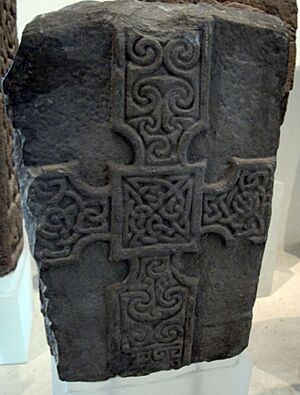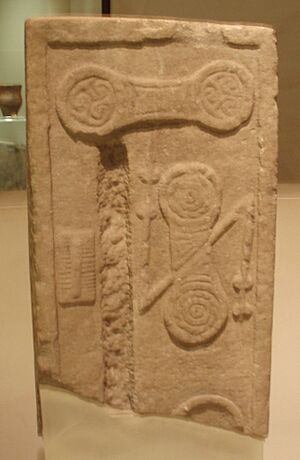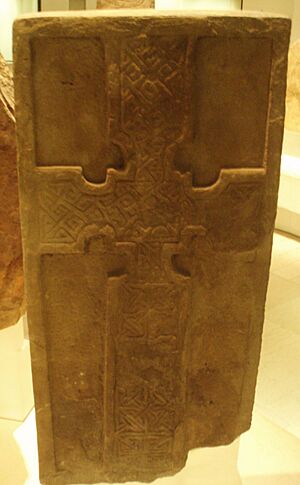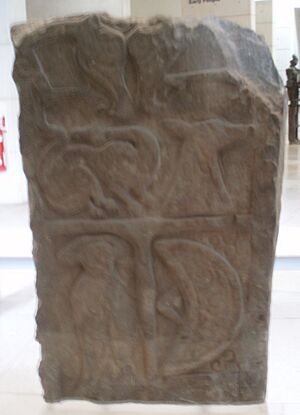Monifieth sculptured stones facts for kids
The Monifieth Sculptured Stones are a group of five ancient stones from Scotland. They were made by the Picts, a group of people who lived in Scotland a long time ago, and also show Christian symbols. These stones were discovered near St Regulus' church in Monifieth, Angus, Scotland, mostly when old church buildings were being taken down. Today, you can see all five stones at the Museum of Scotland in Edinburgh.
Contents
Where Were the Stones Found?
The stones known as Monifieth 1, 2, 3, and 4 were found at St Regulus' Church in Monifieth, Angus, Scotland. Monifieth 5 was found there later. One stone, Monifieth 4, might have originally been at a place called St Bride's Ring in Kingennie and was moved to Monifieth a very long time ago.
Now, all five stones are kept safe at the Museum of Scotland in Edinburgh, where people can visit and learn about them.
The Story Behind the Stones
The church and land in Monifieth were once owned by a group of monks called the Céli Dé. Later, around the early 1200s, the church was given to a big monastery called Arbroath Abbey.
Over many years, old church buildings were replaced with new ones. When a church was being taken down in 1812, workers found parts of even older buildings. They also found some of these special stones! For example, a piece of a tall stone cross was used as a doorway beam in the old church. This cross piece, now called Monifieth 4, might have come from a place several miles away.
People started to notice these ancient stones. In the mid-1800s, two sculptured stones (Monifieth 1 and Monifieth 2) were taken out of the church walls so they could be drawn for a book about Scotland's carved stones. Later, a third stone (Monifieth 3) was found in a nearby garden. These first four stones were given to the Museum of Antiquities (which is now part of the Museum of Scotland) in 1870.
Even later, in 1928, another piece of a tall cross (Monifieth 5) was found in the churchyard wall. It looked similar to Monifieth 4 and was also given to the museum.
What Do the Stones Look Like?
These stones are classified into different types based on their carvings. Class II stones have both Christian symbols and older Pictish symbols. Class III stones have only Christian symbols.
Monifieth 1: A Stone with Many Symbols
Monifieth 1 is a tall, flat stone made of grey sandstone. It's about 0.72 meters (about 2.3 feet) tall.
- Front Side: This side has a cross carved into it with cool patterns inside, like a maze or puzzle. A thick border goes around the edge of the stone.
- Back Side: This side is very interesting! It has two "double disc" symbols, which are common Pictish designs. One has a "Z-rod" attached, and the other doesn't. There's also a comb symbol. Part of this side is damaged because the stone was used in the church wall. At the bottom, there's a hint of a circular symbol, which might have been a mirror, often seen with a comb symbol.
Monifieth 2: A Cross with Creatures
Monifieth 2 is another Class II stone, also made of grey sandstone. It's smaller, about 0.45 meters (about 1.5 feet) tall, and some parts are worn away.
- Front Side: Like Monifieth 1, it has a cross with detailed knotwork and spiral designs.
- Back Side: This side shows a variety of symbols. At the top, there are creatures with bird heads. Below them, you can see a long-necked creature and a deer's head. There's also a crescent shape with a "V-rod" design. In one corner, there's a worn figure that looks like the Virgin Mary, wearing a cloak and a halo.
Monifieth 3: Horseback Riders and Monsters
Monifieth 3 is also a Class II stone. It's about 0.45 meters (about 1.5 feet) tall.
- Front Side: This side has a cross shaft (the main part of the cross) with birds and animals carved on the sides.
- Back Side: This side is full of action! It shows a person riding a horse, a crescent symbol, a dog, and even a fish monster. There's also a scene of a dog chasing a stag (a type of deer) and two biting heads.
Monifieth 4: A Tall Cross Fragment
Monifieth 4 is the largest of the stones and is a piece of a free-standing tall cross. It's a Class III stone, meaning it has Christian images but no Pictish symbols. It's about 1.16 meters (about 3.8 feet) tall.
- Front Side: The top part shows a scene of Jesus on the cross, but the upper part of Jesus's body is missing. Two human figures stand next to his legs. Below them are two robed figures holding objects that are hard to identify. Even further down, two figures are holding drinking horns, and at the very bottom, there's a seated person playing a harp, similar to a figure on another famous cross called the Dupplin Cross.
- Back Side: This side has a knotwork design that forms a circle, and below it, a creature biting its own back.
- Sides: The sides of the cross also have knotwork patterns and strange, imaginary creatures.
Monifieth 5: Another Cross Fragment
Monifieth 5 is another piece of a Class III tall cross, broken off below where the arms of the cross would have been. It's about 0.5 meters (about 1.6 feet) long.
- Front Side: This side also shows part of a crucifixion scene, with the figure of Jesus broken off at the waist. Two figures are on either side of his legs. The lower part of the cross is very worn, so any designs there are hard to see.
- Rear Side: The back of this cross piece is also too worn to make out any clear designs.






